Wovens, Knits, & Sewing them Together
2018 Sep 15th
The world of textiles is vast and varied. Walking into a well stocked fabric store is, to me, similar to the feeling I get when I walk into a bookstore or a library. So many possibilities!
Patterns are generally designed to be used with a specific type of fabric. In most cases, there is one very basic distinction that will at least get you headed to the right section of the store... identifying whether a fabric is woven, or knit. These are the most simple categories that fabric can be divided into, and it's important to understand the differences. Once you know the basics, I'll share some tips about these two very different fabric types, and how you can sew them together in one garment.
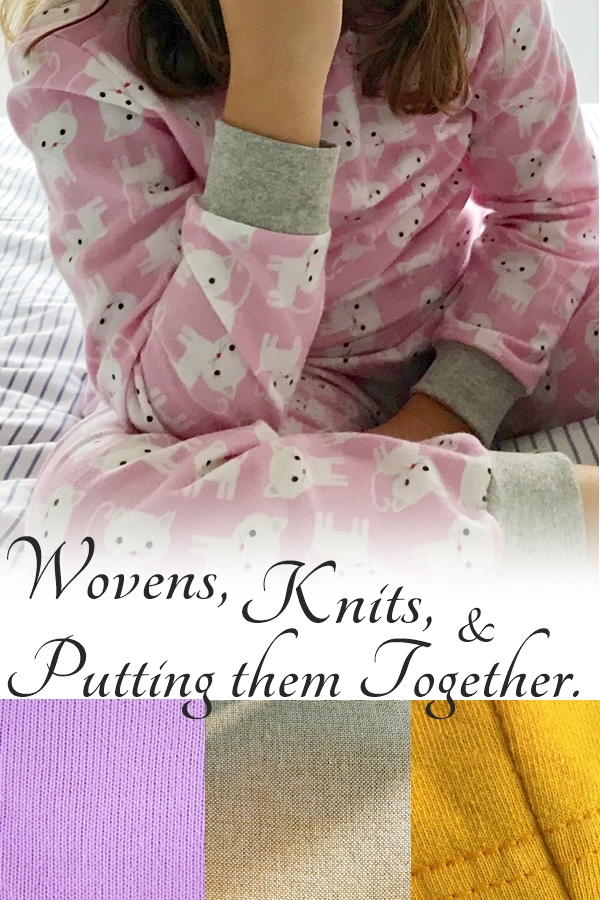
First things first... What is Woven & What is Knit.
Woven fabric is any fabric that is constructed by "weaving" the fabric together. This means that there are fibers that run horizontally (also called the crosswise grain or 'weft'), and there are separate fibers that run vertically (the lengthwise grain or 'warp'). This fabric is what you would imagine if you picture someone using a loom; there are rows of thread or yarn running in one direction, and additional yarn is woven perpendicularly over and under them. You see it in basket-making, and when you were a kid you may have even done this with strips of paper. Burlap is an example of a textile that very clearly shows the weave of the fibers.
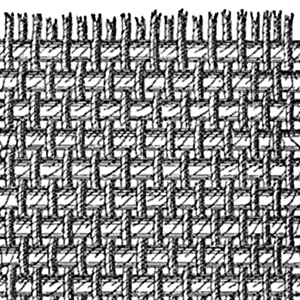
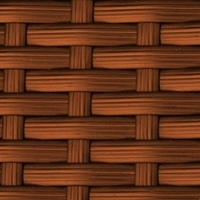
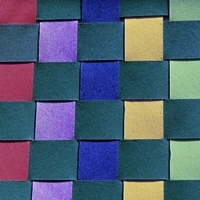
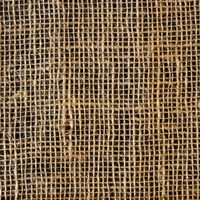
Woven fabric can be made in various densities. Wider yarns and string can be woven to create beautiful colorful blankets, but it is very tiny barely distinguishable thread that is woven by machine to create the typical garment or quilting fabrics you find in fabric stores. The more tightly woven the fibers, the more stable the fabric.

More characteristics of woven fabric:
- Unless they have stretch fibers woven into them (as in the case of stretch denim), woven fabrics do not stretch when you pull them in a horizontal or vertical direction. There do have a little stretch when pulled diagonally (also called "on the bias"), but only because of the way the fibers move, not because the threads themselves are stretchy.
- Woven fibers fray because when you cut an edge, the fibers closest to the cut have nothing securing them in place. Therefore, you must finish the raw edge of all woven seams to prevent them from fraying. Finishing is done with a serger, by zigzag stitching over the edge, or by folding the edge under such as with a hem or french seam.
- Woven fabrics require either a universal or a sharp needle. The weight/thickness of the fabric will determine the type of needle that is needed.
- Woven fabrics are better for holding an edge, such as a pleat.
- Woven fabrics are also more stable, making them the preferred choice for formal or tailored garments, and they can be used to stabilize other fabrics.
- Patterns designed for woven fabric need to have more ease because they can't stretch to fit.
Examples of woven fabrics include: denim, twill, linen, flannel, broadcloth, poplin, lawn, satin, chiffon.
Knit fabric is constructed of a single yarn or thread that is "knitted" into interconnected loops. If you've ever seen someone knitting with knitting needles, you may have observed that there is only one ball of yarn actually being used at a time. Only when the knitter reaches the end of one ball or wants to change colors, is another ball started. Basically, the yarn or thread goes under a loop from the previous row, picks up a new loop, and pulls it up onto the next row. This repeats over and over until it is either turned and the next row is created on top of the previous one, or it continues to be knitted in around in a circle or tube.
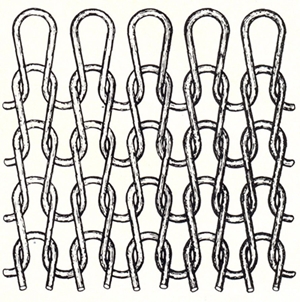
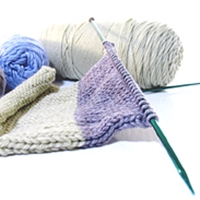
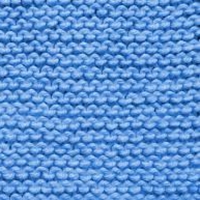
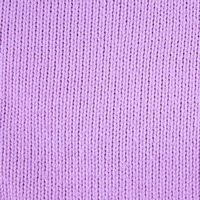
Which side of the fabric the loops are looped from changes some of the characteristics of a knit fabric. Melly Sews does a great job of explaining this in more detail, so if you are curious about that, check out her article about Types of Knit Fabric. As with wovens, knit fabrics will look different depending on the type and thickness of fibers they were made with, and the style of the knitting. Thick or thin yarns are used to create sweater knits, and design features can be added, including raised bumps called ribs. Thin threads are knitted by machine to make the material that is used for garments such as t-shirts and athletic wear. Though you have to look closely, you can see that the interlinking loops appear the same as with fabrics knit with thicker yarn.
There are also other types of knit that are made with fibers that are very hard to see with the eye, such as fleece fabric. (Fleece is a whole other fascination when it comes to textiles... check out my Sewing with Fleece Series for lots more about that one!)
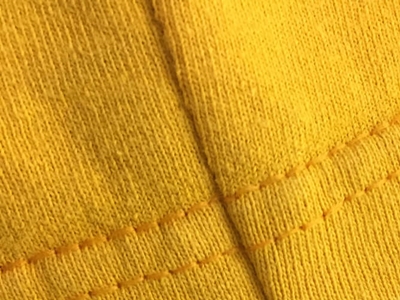
Examples of knit fabrics include: jersey, interlock, ribbing, sweater knit, fleece, french terry.
- The truly defining characteristic of knit fabrics is that they stretch. Some stretch only horizontally (2-way stretch) and some stretch both vertically and horizontally (4-way stretch). Different knit fabrics will have different amounts (or percentages) of stretch.
- Different knits will also have different "stretch recovery". This refers to how quickly and how well a fabric returned to it's original state after it has been stretched. Knits with very good recovery are needed for garments that are meant to fit close to the body (such as underwear, swimsuits, and athletic clothing), and for any area of a garment that you do not want to have stretch out (such as collars). The second part of my Sewing With Fleece Series talks more about stretch recovery, and how to do a Stretch Test.
- Fabric that stretches is a bit trickier to stitch. If the fabric is stretched WHILE you are stitching, the resulting seam appears wobbly. The key is to make sure you are not pulling back on the fabric as it goes under your sewing machine foot... and always TEST first so you know how your machine handles the fabric and where to set your stitch length and tension. A walking foot is incredibly helpful, as is reducing the pressure of your sewing foot if you can.
- Knit fabric requires a stretch stitch, so that the stitches don't break when the fabric is stretched. A simple zigzag is a stitch that will stretch with the fabric and is available on all machines. Other options include a blind hem stitch, straight stretch, tricot, or double needle. A serged edge also stretches, so you may in some cases be able to simply serge the seam and not use your sewing machine at all.
- Knit fabrics often require a "stretch" or "ballpoint" needle. Stretch needles have a dull tip, allowing them to slide between the fibers, rather than possibly piercing or tearing through the thread which can result in small holes or runs.
- Because of the interlocking loops, a cut edge of knit fabric will not fray or unravel, and therefore does not need to be finished. Knit fabrics may curl along a cut edge though, which can be a little tricky when cutting and lining up pattern pieces.
- Knit garments tend to be more casual and have less ease (be more form-fitting). In most cases, a pattern designed for knit will not fit comfortably, or at all, if made with woven fabric.
Now comes the Fun Stuff... Putting Wovens & Knits Together!
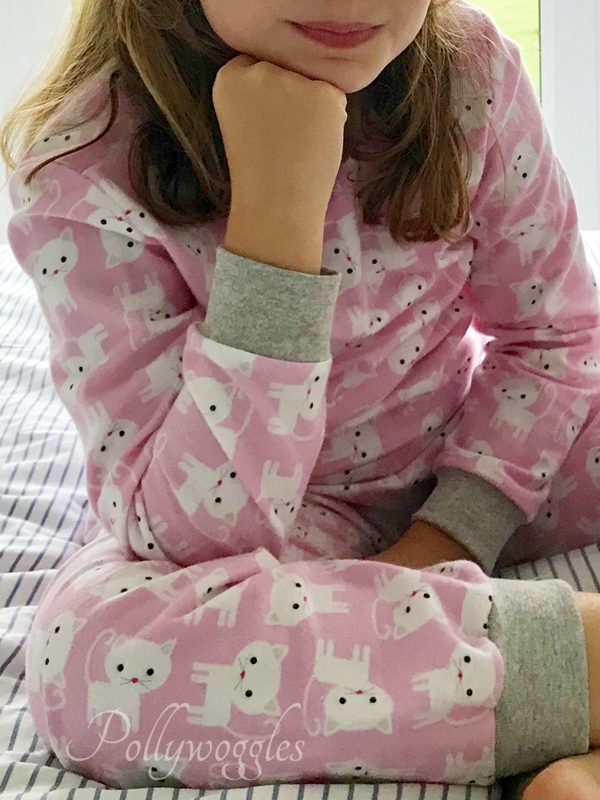
In my Simcoe pajama pattern, the main parts of the pattern (pants/shorts, shirt front and back, and sleeves) are designed to be made with woven fabric, such as quilting cotton or flannel. The cuffs, collar, and bottom hem of the shirt call for knit that has good recovery, such as ribbing or interlock. Quality cotton lycra is also a good option if you don't have those; it is just often a little thinner so may be less stable than ribbing or interlock.
With this pattern, the knit that is being attached is smaller than the opening that it will be attached to, This means that the knit fabric will pull slightly at the seam, similar to the way elastic behaves in a waistband, causing the woven fabric to bunch up along the seam. Because this is intentional, this combination is very easy to stitch together as you do not need to worry about the knit fabric stretching more than it is meant to.
In all cases of sewing a knit and a woven fabric together, I personally recommend starting off with simply a universal needle, and a regular straight stitch or very narrow zigzag.
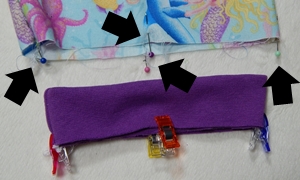
1. Mark the seam(s) as well as evenly spaced points around both pieces that will be attached together (in this case, both the cuff and pant leg are marked in quarters).
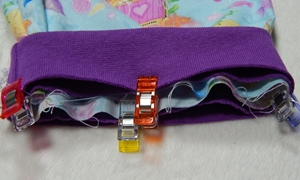
2. Next, match up the points you marked. This ensures that the knit is evenly spaced around the woven, even though they are different sizes.
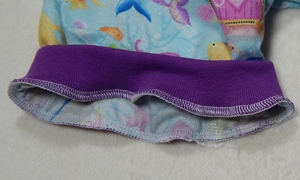
3. Stitch together, STRETCHING as you stitch. The woven fabric will not actually stretch (with one exception, which I'll talk about more below), which is why a regular needle and straight stitch are usable... the stitches themselves don't have to stretch.
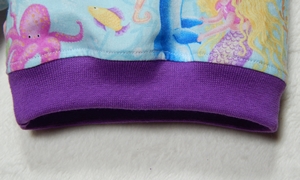
4. Turn right side out. If you choose to topstitch, press the seam allowance up so that is is caught in the topstitching. And again STRETCH as much as the woven fabric will allow as you stitch.
There are some conditions however, where you need to take special care when stitching wovens and knits together...
- When attaching a knit collar to a woven neckline is one case where the neckline DOES have some stretch to it even though it is woven. The reason for this is because the woven neckline is cut on a curve. Anywhere that the woven fibers are cut diagonally will have some stretch to it. You can still use a regular needle and a straight stitch, BUT you should be a little extra cautious that you are not overstretching the material. You want the knit to stretch to FIT the woven, not be stretching both the knit and the woven too much beyond the natural curve of the neckline.
- If you are stitching together a knit and a woven that are the SAME length, you want to make sure that you don't stretch the knit at all. If you do, it will not match up evenly along the seam and you will get puckers or wavers in the finished seam. In this case. a walking foot is very helpful to keep the knit moving at the same time as the woven. If you do not have a walking foot, you should test with some scraps first whether your machine feeds more evenly with the knit on top of the woven, or the other way around. If you do find your seam looks a little wavy when you are finished, a trip through the washer and dryer may take settle it down a bit.
- If a pattern has enough ease (meaning it is not too snug fitting) to allow a woven skirt to be attached to a knit bodice, this can create some fantastic outfits! One difficulty you might run into though is that the knit may not have enough stability to hold the weight and drape of the woven without pulling unattractively at the seam. To combat this, you should add some stabilization to the seam. One good option is clear elastic that is exactly the same width as the bodice. This adds some structure to the seam.
- Keep in mind that while knit fabrics don't fray, wovens do. So any time your are putting the two together, you will need to either finish the seam after stitching them together, or finish the edge of the woven fabric with pinking shears before stitching it to the knit.
Perhaps you have some tips to share too about sewing woven and knits together? I'd love to hear your experiences! I really enjoy the affect of combining these two types of fabrics... so perhaps in the future you will see more woven/knit combinations in my collection!


